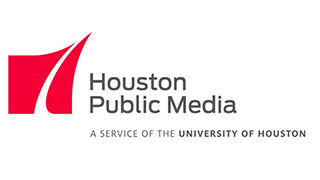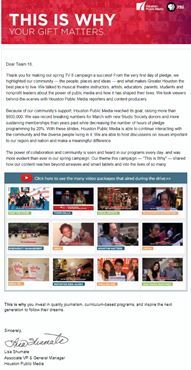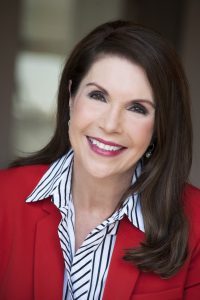Targeted impact messaging and deepening relationships lift net revenue at HPM

Targeted impact messaging and deepening relationships lift net revenue at HPM

Houston Public Media activated a new strategy in the fall of 2017, to drive toward a more philanthropic giving model for both radio and TV pledge – through storytelling. The goal of our pledge drives for both TV and radio is to offer fewer premiums, no tickets, and tell the story of how members impact the residents of the Greater Houston area with their support to HPM – “Why Your Gift Matters”. Our strategy focuses on philanthropic, cohesive, multi-platform messaging.” Lisa Shumate, Associate Vice President & General Manager, Houston Public Media
Like several other stations, Houston Public Media has been testing a new strategy around pledge that involves messaging and relationship building. They have updated and synchronized all communications, talking more about the station’s overall mission and the impact of giving, all the while cutting down on the premiums offered as thank you gifts and decreasing pledge minutes. Along with these changes, HPM took a significant risk by replacing many of the PBS pledge breaks with their own pre-produced stories of impact.
Besides the reduction in pledge programming, what changed between last year and this year? “Deepening personal relationships,” says Lamm. “That’s the driving factor.”
How did this get started?
The strategy began with a series of face-to-face meetings with members of their Studio Giving Society. This group comprised sustaining donors who gave at least $100 per month. “We soon realized most of our major donors didn’t have a personal relationship with anyone [at the station],” Lamm says. “We decided to ask them what the Studio Society should look like. It was also an opportunity to find out what they knew about the station and what we were doing.” So, we designed a survey to learn more.
Surveying these donors, station personnel dug into why they supported public media. An immediate and positive result of these in-depth conversations was increased giving from this group of donors. “Those who were giving $1,200 were now giving $2,000” she says. HPM took the information from the donors and began to evaluate it in terms of what Lamm describes as the four “pillars” of the station’s mission: education, arts and culture, news and information and public safety.
Adjusting the Language
One of the questions asked in the survey was “What are your thoughts about on-air drives?” Lamm says most of the feedback was negative. “They felt we were talking heads pushing product,” she says. “We talked about $5 or $10 gifts and ‘Do your part for $5 a month.’ They felt like they were doing their part—but giving a lot less than they could be giving.” Drawing from the survey responses, the station began to develop pledge scripts (for radio and TV) that spoke about the work of HPM and the impact of supporters’ gifts. “We also increased what we were asking for and added a call to action.” On-air, the station set the threshold at $10 a month, saving the requests for $5 monthly gifts for mail and email.
Lamm also coordinated with all departments to make sure every form of communication spoke in terms of impact. “Before this change, there was one message coming from our major donor group, a different message from membership, and even underwriting was doing its own thing,” she says. “I wanted to have a fully integrated messaging strategy – where all teams are saying the same thing in the same way.”
Educating Viewers, Listeners, and Donors

Donors also mentioned in the survey that knowing specific details on how their gifts made an impact would be of value to them. HPM developed scripts for pledge that communicated these details, from serving more than 100,000 local families through an annual spelling bee to offering more than 600 hours of arts programming. “We were quantifying the messaging to really demonstrate the impact we make on the community,” Lamm says.
Link to Engagement Letter to Reinforce Impact
Another survey question related to the understanding of the station’s financial model: When you think of Houston Public Media, do you think of it as a media company or a nonprofit? “A lot said we were a media company. So in some of our scripts we talked about how we’re a not-for-profit media company to make sure people understand.”
Reducing Premiums
HPM implemented this new plan during the October 2017 radio pledge drive. They worked with Barry Nelson at CDP to write pledge scripts that refocused the message on mission and impact – while cutting back on premiums offered – from 50 to 15. That change was also reflected online. “When you came to the donate page, it wasn’t pages and pages of items to choose from. We only highlighted the items we were talking about that day. It was about giving first, and if you wanted a thank-you item you’d have to do another click.”
The station received positive feedback from listeners and donors because the messaging was different. “We found that after the drive we had raised the same amount of money but had fewer expenses,” says Lamm. Shifting that successful strategy to December TV pledge was the next step in the plan. HPM reduced premiums there as well. “We opted in for the most expensive packages. Instead of offering the typical combo-package, we offered one—the most expensive one for that program,” she says. “We figured if we were going to ask for a transactional gift, then we would secure the most we could. We came out of the drive with higher net revenue than the year before.”
For the same reason it has reduced premiums, HPM also stopped producing ticketed events, choosing to deploy those resources to fundraising instead.
After December pledge ended on December 10, the station began airing radio, television and digital spots highlighting the impact of giving. “These were 60-second, 30- and 15-second spots with the GM, myself, and other leadership positions talking about why [giving] is important,” Lamm says. “We aired these spots from December 11th until January 1.” All of the giving during this time was philanthropic—no premium requests—and we raised $50,000 more than the same period in 2016.
As of January, the station’s revenue was up and expenses related to premiums were down 25 percent.
Telling Stories

Ultimately, HPM decided the best way to push impact was to tell stories. Those pre-taped stories formed the bulk of TV pledge communications during March of 2018. “Instead of your traditional live pledge event where people are talking about the show and the gift, these pledge events were pre-taped,” Lamm says. With a toss and tag from the station’s GM, Lisa Trapani Shumate, the station created 12 story packages or mini-documentaries. Each averaged the same length as a normal pledge break. They featured community members—including children—talking about how they had benefited from HPM content and/or a community program. The topics aligned with the pillars of the station’s mission. “Hearing the stories of impact from those who benefitted from the service — that’s the difference. It’s not station personnel or volunteers talking about it. It’s the actual people that we impacted,” Lamm explains.
As a result of these strategies, the most recent March pledge drive saw significant improvement across the board. The percentage of donations with thank-you items dropped from 95 percent last year to 78 percent. Online gifts brought in $18,000 compared to a usual amount of less than $2,000. After pitching its sustaining Studio Society membership for $100 a month, HPM saw five new Studio Society donors join with an average gift of $2,900. Acquisitions and renewals were also substantially higher.
Then there were the matching gifts. “I’ve been here for five years. Before this year, we were lucky if we had $10,000 in matches for TV,” Lamm says. But in March 2018, donors offered $152,000 in matching grants. “We’re seeing fewer donors coming in but with higher gifts.”
Changing the Culture
The emphasis on mission, telling impact stories, and communication with donors all comes down to a renewed focus on creating meaningful conversations between Houston Public Media and its supporters. “We were having a hard time not only establishing those relationships but then also maintaining them and deepening them because our donors were used to being talked to during drive not engaged in any way,” says Lamm. “But once we changed how we talked to our donors and what we were telling them, it was surprisingly easy to increase fundraising. Our major gifts program has doubled in the last 18 months and that’s strictly because of the stronger relationships we have with these donors.
This new strategy has changed the whole culture of the station and everyone who works here. The idea of an integrated messaging campaign has everyone thinking in the same way. Now, everyone in the building is a fundraiser.”
Questions? Tracy Ferrier I Director I PBS Development Services or Courtney Lamm I Chief Development Officer I Houston Public Media
Comments
MELINDA HOKE, VP PHILANTHROPYI am glad you have taken this step–it makes total sense to me. With our individual donors of $1,000 – $100,000+, impact is our approach to raise giving. In 2 1/2 years, we increased giving from roughly $850,000 to 2. 6 Million. I believe that an impact experience throughout the donor journey is what really matters to the donor and the community. At TPT we have an impact officer who is working with us to define and integrate impact across the station.
MELINDA HOKE, VP PHILANTHROPYCongratulations! At Twin Cuties PBS when we shifted our Major Giving program from Transactional Giving to Invested Philanthropy, we nearly tripled our revenue and sustained it. I am a firm believer that this cultural shift needs to occur throughout the system. We have been undervaluing public media for decades. Now we are able to demonstrate that donors will fund us at their actual value of us because of our impact on them and our communities. I will be glad to share our methods and results at TPT.
HEATHER DUFFY@Melissa Hoke, is there a place where you have shared the TPT methods/results? I am just back from maternity leave, so I don’t want to assume they were not shared while I was away. Our development department at WGVU (West/Southwest Michigan) is a team of folks with diverse non-profit org backgrounds, and we are very interested in ways other stations have succeeded in shifting the giving culture from a transactional model to one of Invested Philanthropy. Thanks!
